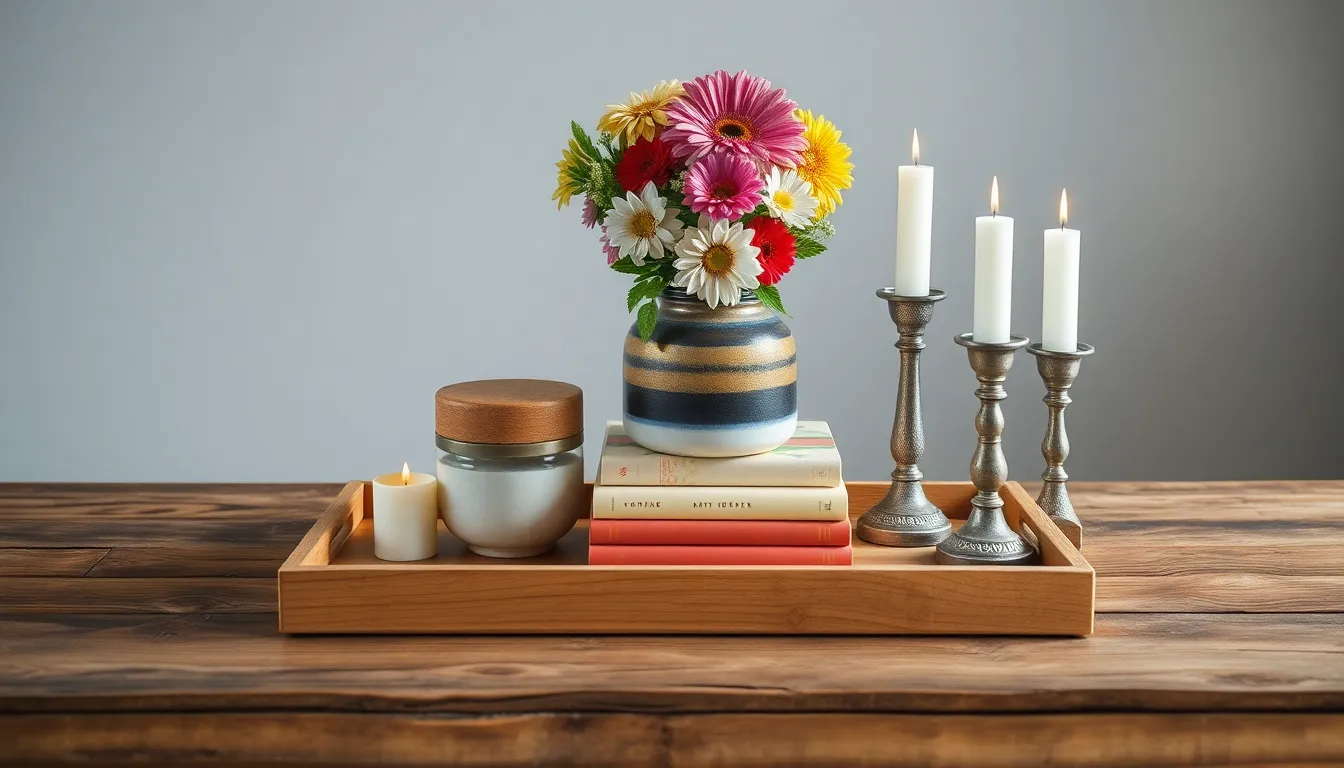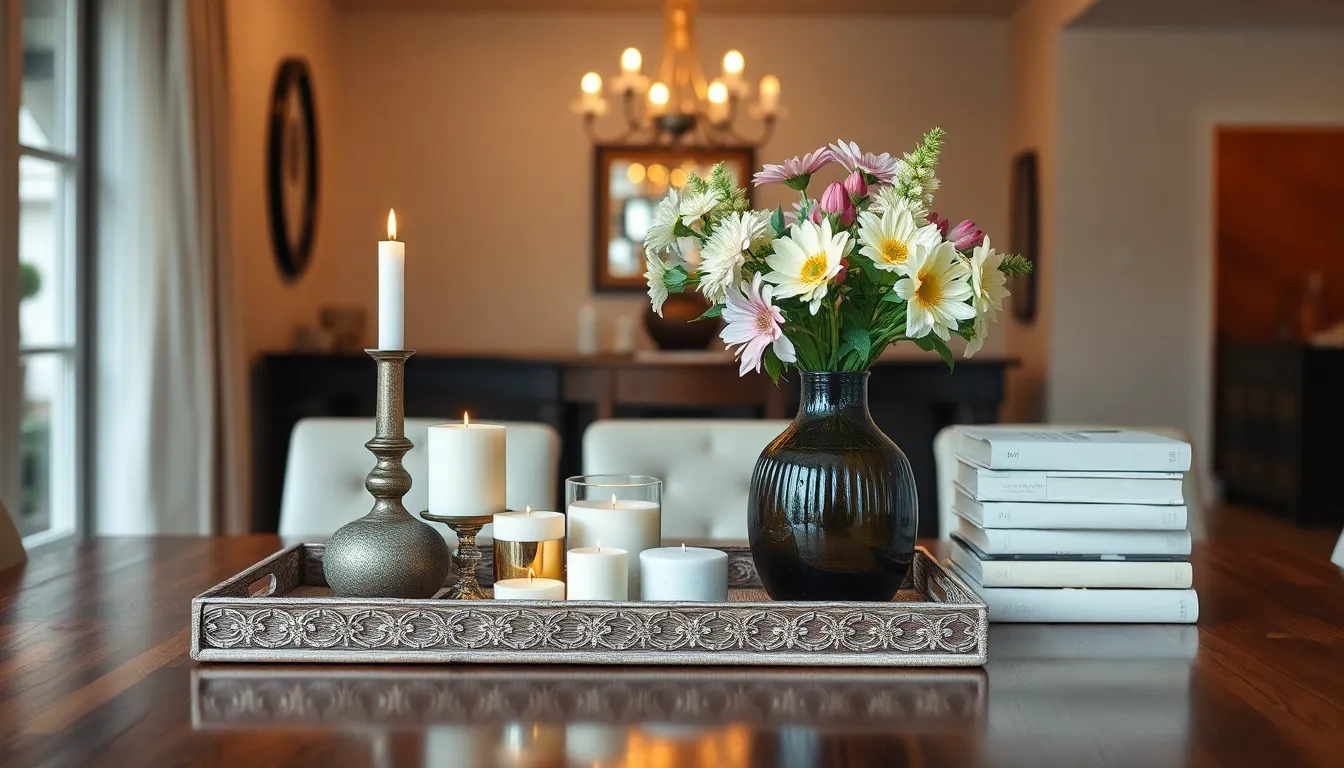Creating a stunning tabletop vignette is like crafting a mini masterpiece that tells a story. Whether it’s for a dinner party or just to impress the cat, a well-styled tabletop can elevate any space from drab to fab. But let’s face it: arranging that perfect display can feel more daunting than finding a needle in a haystack—especially when the haystack is your cluttered dining table.
Table of Contents
ToggleUnderstanding Tabletop Vignettes
Creating tabletop vignettes involves arranging decorative elements that convey a story or theme. These small displays enhance the aesthetic appeal of a space and serve as focal points in any room.
What Is a Tabletop Vignette?
A tabletop vignette consists of a carefully curated selection of items displayed on a table. It combines various objects like candles, books, and flowers to create visual interest. Each element complements the others and contributes to an overall narrative. Designers often use height variations and contrasting textures to guide the viewer’s eye. Balancing these components ensures a cohesive look that draws people in.
Importance of Tabletop Vignettes in Design
Tabletop vignettes play a crucial role in interior design. They add personality and character to otherwise sterile spaces. A well-styled vignette can transform a dining table into a conversation starter during gatherings. Designers use these arrangements to influence mood and atmosphere. Effective vignettes create delightful visual experiences and enhance the functionality of a space. Thoughtfully designed tabletops demonstrate a homeowner’s style and attention to detail, leaving a lasting impression.
Essential Elements of Tabletop Vignettes

Creating an effective tabletop vignette relies on a few essential elements that work together to form a cohesive arrangement. These elements encompass choosing the right base, selecting focal points, and incorporating accessories.
Choosing the Right Base
Selecting an appropriate base enhances the overall display. It acts as the foundation for the vignette, so consider using trays, table runners, or even the tabletop itself. A well-chosen base provides structure and defines the vignette’s boundaries. Choose colors and materials that complement the items featured. Wood, metal, or woven materials can add different textures and visual appeal. Additionally, ensure that the size of the base accommodates the selected pieces without making the arrangement feel cluttered.
Selecting Focal Points
Focal points serve as the centerpiece of any vignette and draw attention. Choose a standout piece that captures the viewer’s eye, such as a striking vase, a unique sculpture, or an interesting book stack. Layer additional elements around the focal point to create depth and visual interest. Vary the heights of the objects to emphasize the focal point further. Groups of three or five items often work well, facilitating balance and harmony in the arrangement. Balancing larger elements with smaller accents creates a more dynamic vignette.
Incorporating Accessories
Accessories can elevate a vignette by introducing complementary elements. Candles in varying heights add warmth and ambiance, while decorative objects like bowls or figurines add character. Incorporate natural elements, such as flowers or greenery, to breathe life into the display. Textiles, like tablecloths or napkins, can introduce color and texture, enhancing the overall aesthetic. Place accessories thoughtfully within the arrangement to avoid overcrowding and ensure a cohesive look. Successful accessorizing ties the design together, reinforcing the intended theme.
Tips for Creating Stunning Tabletop Vignettes
Creating a striking tabletop vignette involves thoughtful design choices that enhance your space. These tips provide a clear path to achieving beautiful arrangements.
Balanced Composition Techniques
Balanced composition plays a critical role in picnic vignettes. Establish focal points using varying heights, such as tall candlesticks or low bowls, to draw attention. Group decorative items in odd numbers for visual interest. Ensure not all pieces center on one area; distribute elements evenly across the surface. Incorporate both large and small items to create depth and intrigue. Utilize symmetry or asymmetry according to the desired effect, making the arrangement feel harmonious or dynamic. Each choice influences the overall aesthetic and narrative of the vignette.
Color Schemes and Textures
Choosing a cohesive color scheme and diverse textures elevates tabletops. Select a base palette that complements the room’s decor, usually comprising three to five colors. Incorporate neutral tones for grounding against bolder shades. Textures also add depth; mix smooth ceramics with rough wood or soft fabrics. Accessories like glass or metallic decor create contrast, enhancing the visual appeal. Consider incorporating seasonal colors for added relevance, as they can transform the vignette easily. Consistency in color and texture maintains unity within the vignette while allowing creativity to shine.
Seasonal and Thematic Inspiration
Drawing inspiration from seasons and themes helps in creating timely vignettes. Think of warmer tones and natural elements for autumn, while spring invites flowers and light pastels. Incorporate holidays and events, such as using pumpkins, pinecones, or ornaments to reflect the season. Themes can also guide the vignette style; beach elements, for instance, fit well in a summer display. Create continuity by using seasonal colors across accessories like linens and tableware. Aligning with popular celebrations or themes makes vignettes fresh, engaging, and relevant throughout the year.
Common Mistakes to Avoid
Mistakes can easily disrupt the beauty of a tabletop vignette. Keeping these common pitfalls in mind enhances the overall aesthetic.
Overcrowding the Space
Overcrowding leads to cluttered vignettes that lack visual clarity. Designers recommend limiting the number of elements to maintain interaction among items. Three to five key pieces often create balance and harmony. Each item should have room to breathe and stand out without competing for attention. A busy arrangement distracts from the overall theme, making it hard for viewers to appreciate individual elements. Prioritize space to foreground the story behind the vignette.
Ignoring Scale and Proportion
Ignoring scale and proportion can result in unappealing arrangements. When items are too large or too small relative to each other, the vignette may look uncoordinated. For instance, a tiny candle beside a massive sculpture can make both elements lose impact. Choose pieces that complement each other’s size to create a cohesive appearance. Consider using varying heights to add interest while ensuring everything works well together. Achieving proper proportion allows viewers to enjoy the vignette’s overall aesthetic without distraction.
Creating a stunning tabletop vignette is an art that transforms any space into a visual delight. By thoughtfully selecting and arranging elements, it’s possible to tell a story that resonates with guests and enhances the overall atmosphere.
Attention to detail in composition and balance is key. A well-curated vignette not only reflects personal style but also invites conversation and admiration.
With a few practical tips and an eye for design, anyone can master the art of tabletop vignettes, making their home feel warm and inviting. Embrace creativity and let each vignette showcase individuality while adding charm to everyday life.








